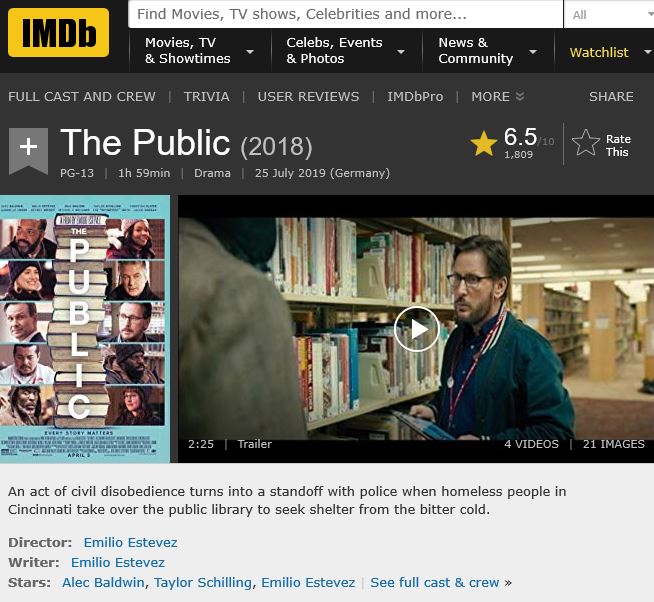The thinking of Comrade F. Dobler from the early 20th century remains relevant and even prescient: those who need open access to information may be those who are fundamentally excluded from public libraries.

Reviewing The public
Open for all? offers a “think piece” rather than an intellectual analysis. Columnist John Pateman shares his personal observations on issues, and his columns are designed to promote discussion and professional debate. He has arrived at his conclusions after 40 years of working in public libraries of/in all types and locations.
The public is my kind of movie. The hero is a flawed character with a shady past who has been given a second chance. He uses this opportunity to help those who are in the same bad place that he used to occupy. The plot pitches the underdogs of society against the forces of bureaucracy, political ambition, and law and order. The movie poses moral dilemmas such as “Whose side of right are you on?” and “Are you one of us or one of them?” The good guys win the battle but not the war. The struggle continues.
You probably think that you’ve already seen this movie. The plot and the characters may sound familiar. This popular and successful Hollywood formula has hit the silver screen in many variations. But you haven’t seen anything like The public before. This movie is set in a public library and the hero is a librarian: Stuart Goodson. That is a Hollywood first. Media portrayals of librarians are seldom kind and never heroic. The ageing, rule-bound spinster is the typical stereotype.
But Mr. Goodson is different. The public library saved him from a life of homelessness and addiction. He knows what it feels like to be down and out. Now he wants to help the homeless people who take shelter in his library during a bitter Midwestern winter. When a homeless patron dies of exposure right outside the library, the scene is set for a confrontation between the establishment and the public library.

I won’t say any more, because I don’t want to spoil the movie for anyone who hasn’t seen it yet. But I would urge you to go to see The public or to borrow/buy it on DVD. It goes to the heart of what we are trying to do at Thunder Bay Public Library (TBPL). I have written and spoken extensively about the need to transform TBPL from a traditional to a community-led and needs-based library. I’m often asked what a needs-based library looks like, and I can now answer that question by saying “Go and see The public.”
This movie was inspired by Chip Ward, the former assistant director of the Salt Lake City Public Library. Ward wrote an article in 2007 entitled What they didn’t teach us in library school: The public library as an asylum for the homeless, in which he articulated his vision for a relevant public library. According to Mr. Ward:
[…] The Salt Lake City Public Library […] has created a place where the diverse ideas and perspectives that sustain an open and inclusive civil society can be expressed safely, where disparate citizens can discover common ground, self-organize, and make wise choices together. We do not collect just books, we also gather voices. We empower citizens and invite them to engage one another in public dialogues. I like to think of our library as the civic ballroom of our community where citizens can practice that awkward dance of mutuality that is the very signature of a democratic culture.
The public was written and directed by Emilio Estevez, who also played the main character (Stuart Goodson). In an interview with Phil Morehart for American libraries, Estevez is very clear that “It is a moral imperative for libraries and other public spaces to help the homeless and other populations in need. If you possess a beating heart that is as close to an inarguable statement as you are likely to hear.”
Estevez also points out that “I learned quickly that what most librarians went to school to study and earn a degree in has very little practical application on the floor. A modern-day librarian is now a de facto social worker and first responder. It’s not unusual for librarians to be trained in the use of Narcan, a nasal application used to treat opiate overdoses.”

Denver Public Library has responded to the opioid crisis by establishing a Community Resource Program. As described in an article for WebJunction:
The program launched in 2015 as a solution to staff interest in better serving individuals experiencing homelessness, and expanded to address opioid-related concerns as community needs changed. The program provides support and counseling to patrons, focusing on trauma-informed services, which is a treatment framework that includes understanding, recognizing, and responding to the effects of all types of trauma.
As the homelessness crisis has worsened, so too has the strain on libraries, and San Francisco Public Library has taken steps to address the problem rather than the symptoms. As Devin Coldewey explains:
Libraries welcome and serve everyone, no matter their age, background or income level. Libraries are also particularly committed to helping the underserved, particularly the insecurely housed,’ […] If that’s the mission, then that’s the mission—if fulfilling that mission looks different today than it did 10, 20 or 50 years ago, that just means we’ve successfully evolved the model.
Peterborough Public Library in Ontario recently responded to a homelessness crisis in the city by providing 15 cots for those in need. These are all great examples of programming in a needs-based library.
________________________________
John Pateman is the CEO of the Thunder Bay Public Library.
